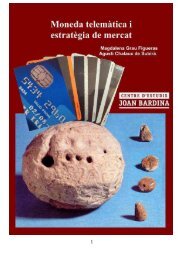Telematic currency and market strategy (mtemuk.pdf). - Centre d ...
Telematic currency and market strategy (mtemuk.pdf). - Centre d ...
Telematic currency and market strategy (mtemuk.pdf). - Centre d ...
You also want an ePaper? Increase the reach of your titles
YUMPU automatically turns print PDFs into web optimized ePapers that Google loves.
After this, the balance present in every barter because of the equivalence of the exchange values of the<br />
exchanged goods will only be reached in the global <strong>market</strong>, because the various elemental money changes in<br />
which every barter has been dissociated are not necessarily balanced in their turn.<br />
To conclude <strong>and</strong> in short, we say that a money instrument is simply «an acceptance of a debt, exactly<br />
documented <strong>and</strong> inter-compensable through a system of personal current accounts, within the whole free<br />
<strong>market</strong> of all the elemental free money changes». In this essay we will talk both of money instruments <strong>and</strong> of<br />
money documents, depending on whether we want to put in evidence its character of technical instrument -<br />
an accounting medium which allows the realization of a new kind of mercantile change- or to put in evidence<br />
its character of a document which exactly registers every mercantile elemental exchange.<br />
It is clear that the elemental money change is much more nimble <strong>and</strong> allows a greater dynamism than the<br />
global money barter. In fact, from now on there is nothing new to be invented as far as the money system is<br />
concerned, since all the fundamental elements are present. The money instrument we have described is<br />
flexible enough to be adapted to any situation, whichever its mercantile complexity. It is only necessary to<br />
update it, depending from the mercantile realities <strong>and</strong> the present technological possibilities.<br />
7. Synthesis on the elements of the money systems.<br />
As a final synthesis we can say that the money systems are complex realities where we will distinguish the<br />
following elements:<br />
1. Real people, <strong>market</strong> agents exchanging real goods within a given <strong>market</strong>. Without this <strong>market</strong> it<br />
makes no sense to talk about money systems.<br />
2. Money units which work as measure units; radically conventional-abstract <strong>and</strong> invented to meet the<br />
need to establish exactly the exchange value of each <strong>and</strong> all the real goods exchanged in a given<br />
<strong>market</strong>.<br />
3. Mercantile values (prices, salaries <strong>and</strong> money) which are mixed items, concrete-abstract, resulting<br />
from comparison between real goods <strong>and</strong> abstract money units.<br />
4. The previous three elements are enough for an underdeveloped <strong>market</strong>; however, in societies with a<br />
greater mercantile dynamism a new element appears: money instruments.<br />
These are an invention of a purely instrumental-auxiliary character to make a new sort of transaction easier<br />
<strong>and</strong> at the same time to record exactly each of the operations effected.<br />
8. Nature of the money systems.<br />
The fundamental conclusion derived from the above is that the money systems are of an exclusively<br />
instrumental nature, conventional <strong>and</strong> abstract.<br />
In any <strong>market</strong> the basic element, the immediate subject of all the utilitarian interests, is constituted by the real<br />
goods. They have an intrinsic value which makes them desirable. They are considered as first realities on any<br />
trade utilitarianism.<br />
A money system, on the contrary, is an artificial construction which is placed over these first concrete<br />
realities, with the only instrumental scope of controlling them more easily <strong>and</strong> effectively.<br />
The real goods <strong>and</strong> the real people who exchange them are the basis of the existence of the money system:<br />
we therefore will consider it a second reality derived from the first one. The second <strong>and</strong> derived money reality<br />
has no intrinsic value, only a purely instrumental value, based on its abstract structure of the metric system.<br />
If historically some forms of money instruments have been given a very concrete intrinsic value -we are<br />
talking about coins or any other form of merch<strong>and</strong>ise <strong>currency</strong>- it does not mean that their being intrinsic is<br />
the defining <strong>and</strong> essential quality of money systems, on the contrary, the essentiality <strong>and</strong> usefulness of money<br />
14



